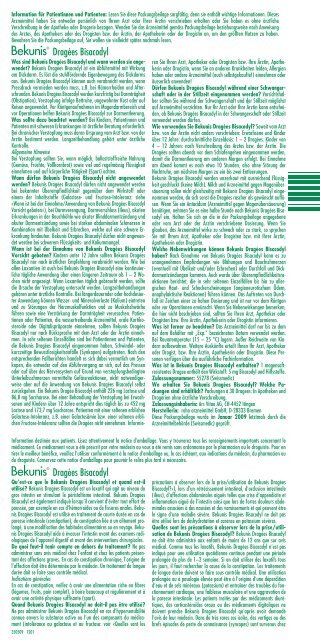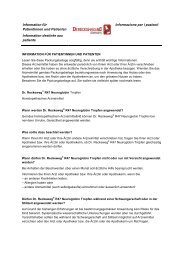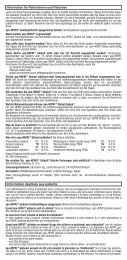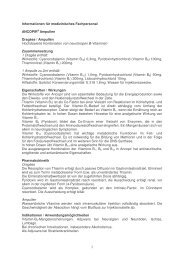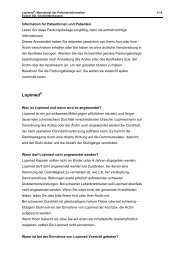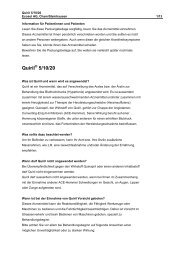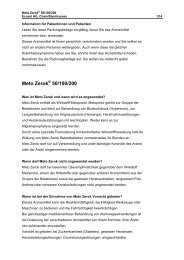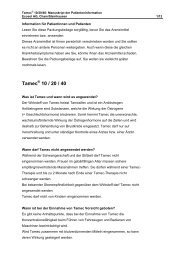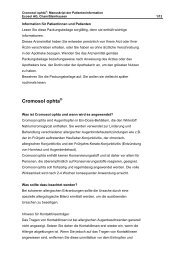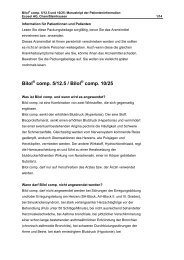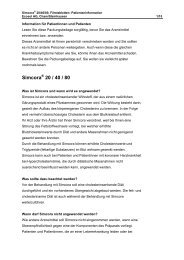Dragées Bisacodyl Dragées Bisacodyl
Dragées Bisacodyl Dragées Bisacodyl
Dragées Bisacodyl Dragées Bisacodyl
Create successful ePaper yourself
Turn your PDF publications into a flip-book with our unique Google optimized e-Paper software.
Information für Patientinnen und Patienten: Lesen Sie diese Packungsbeilage sorgfältig, denn sie enthält wichtige Informationen. Dieses<br />
Arzneimittel haben Sie entweder persönlich von Ihrem Arzt oder Ihrer Ärztin verschrieben erhalten oder Sie haben es ohne ärztliche<br />
Verschreibung in der Apotheke oder Drogerie bezogen. Wenden Sie das Arzneimittel gemäss Packungsbeilage beziehungsweise nach Anweisung<br />
des Arztes, des Apothekers oder des Drogisten bzw. der Ärztin, der Apo the kerin oder der Drogistin an, um den größten Nutzen zu haben.<br />
Bewahren Sie die Packungsbeilage auf, Sie wollen sie vielleicht später nochmals lesen.<br />
<strong>Dragées</strong> <strong>Bisacodyl</strong><br />
Was sind Bekunis <strong>Dragées</strong> <strong>Bisacodyl</strong> und wann werden sie angewen<br />
det? Bekunis <strong>Dragées</strong> <strong>Bisacodyl</strong> ist ein Abführmittel mit Wirkung<br />
am Dickdarm. Es löst die stuhlfördernde Eigenbewegung des Dickdarms<br />
aus. Bekunis <strong>Dragées</strong> <strong>Bisacodyl</strong> können auch verabreicht werden, wenn<br />
Pressdruck vermieden werden muss, z.B. bei Hämorrhoiden und Afterschrunden.<br />
Bekunis <strong>Dragées</strong> <strong>Bisacodyl</strong> werden kurzfristig bei Darmträgheit<br />
(Obstipation), Verstopfung infolge Bettruhe, ungewohnter Kost oder auf<br />
Reisen angewendet. Vor Röntgenaufnahmen im Magendarmbereich und<br />
vor Operationen helfen Bekunis <strong>Dragées</strong> <strong>Bisacodyl</strong> zur Darmentleerung.<br />
Was sollte dazu beachtet werden? Bei Kindern, Patientinnen und<br />
Patienten mit schweren Erkrankungen ist ärztliche Beratung erforderlich.<br />
Bei chronischer Verstopfung muss deren Ursprung vom Arzt bzw. von der<br />
Ärztin bestimmt werden. Langzeitbehandlung gehört unter ärzt liche<br />
Kontrolle.<br />
Allgemeine Hinweise<br />
Bei Verstopfung sollten Sie, wenn möglich, ballaststoffreiche Nahrung<br />
(Gemüse, Früchte, Vollkornbrot) sowie viel und regelmässig Flüssigkeit<br />
einnehmen und auf körperliche Tätigkeit (Sport) achten.<br />
Wann dürfen Bekunis <strong>Dragées</strong> <strong>Bisacodyl</strong> nicht angewendet<br />
werden? Bekunis <strong>Dragées</strong> <strong>Bisacodyl</strong> dürfen nicht angewendet werden<br />
bei bekannter Überempfindlichkeit gegenüber dem Wirkstoff oder<br />
einem der Inhaltsstoffe (Galactose- und Fructose-Intoleranz: siehe<br />
«Wann ist bei der Einnahme/Anwendung von Bekunis <strong>Dragées</strong> <strong>Bisacodyl</strong><br />
Vorsicht geboten»), bei Darmverengung, Darmverschluss (Ileus), akuten<br />
Erkrankungen in der Bauchhöhle wie akuter Blinddarmentzündung und<br />
akuter Darmentzündung sowie bei starken abdominalen Schmerzen in<br />
Kombination mit Übelkeit und Erbrechen, welche auf eine schwere Erkrankung<br />
hindeuten. Bekunis <strong>Dragées</strong> <strong>Bisacodyl</strong> dürfen nicht angewendet<br />
werden bei schwerem Flüssigkeits- und Kaliummangel.<br />
Wann ist bei der Einnahme von Bekunis <strong>Dragées</strong> <strong>Bisacodyl</strong><br />
Vorsicht geboten? Kindern unter 12 Jahre sollten Bekunis <strong>Dragées</strong><br />
<strong>Bisacodyl</strong> nur nach ärztlicher Empfehlung verabreicht werden. Wie bei<br />
allen Laxantien ist auch bei Bekunis <strong>Dragées</strong> <strong>Bisacodyl</strong> eine kontinuierliche<br />
tägliche Anwendung über einen längeren Zeitraum als 1 – 2 Wochen<br />
nicht angezeigt. Wenn Laxantien täglich gebraucht werden, sollte<br />
die Ursache der Verstopfung untersucht werden. Langzeitbehandlungen<br />
gehören unter ärztliche Kontrolle. Bei längerdauernder oder hochdosierter<br />
Anwendung können Wasser- und Mineralverluste (Kalium) eintreten<br />
und zu Störungen der Herzmuskelfunktion und zu Muskelschwäche<br />
führen sowie eine Verstärkung der Darmträgheit verursachen. Patientinnen<br />
oder Patienten, die wassertreibende Arzneimittel, orale Kortikosteroide<br />
oder Digitalispräparate einnehmen, sollten Bekunis <strong>Dragées</strong><br />
<strong>Bisacodyl</strong> nur nach Rücksprache mit dem Arzt oder der Ärztin einnehmen.<br />
In sehr seltenen Einzelfällen sind bei Patientinnen und Patienten,<br />
die Bekunis <strong>Dragées</strong> <strong>Bisacodyl</strong> eingenommen haben, Schwindel- oder<br />
kurzzeitige Bewusst losigkeitsanfälle (Synkopen) aufgetreten. Nach den<br />
entsprechenden Fallberichten handelt es sich dabei vermutlich um Synkopen,<br />
die entweder auf den Abführvorgang an sich, auf das Pressen<br />
oder auf über das Nervensystem auf Grund von verstopfungsbedingten<br />
Unterleibsschmerzen vermittelte Gefässreaktionen, nicht notwendigerweise<br />
aber auf die Anwendung von Bekunis <strong>Dragées</strong> <strong>Bisacodyl</strong> selbst<br />
zurückgehen. Ein Bekunis Dragée <strong>Bisacodyl</strong> enthält 226 mg Lactose und<br />
86,8 mg Saccharose. Bei einer Behandlung der Verstopfung bei Erwachsenen<br />
und Kindern über 12 Jahre entspricht dies täg lich bis zu 452 mg<br />
Lactose und 173,7 mg Saccharose. Patienten mit einer seltenen erblichen<br />
Galactose-Intoleranz, z.B. einer Galactosämie bzw. einer seltenen erblichen<br />
Fructose-Intoleranz sollten die <strong>Dragées</strong> nicht einnehmen. Informie-<br />
Qu’estce que le Bekunis <strong>Dragées</strong> <strong>Bisacodyl</strong> et quand estil<br />
utilisé? Bekunis <strong>Dragées</strong> <strong>Bisacodyl</strong> est un laxatif qui agit au niveau du<br />
gros intestin en stimulant le péristaltisme intestinal. Bekunis <strong>Dragées</strong><br />
<strong>Bisacodyl</strong> est également indiqué lorsqu’il convient d’éviter tout effort de<br />
poussée, par exemple en cas d’hémorroïdes ou de fissures anales. Bekunis<br />
<strong>Dragées</strong> <strong>Bisacodyl</strong> est utilisé en traitement de courte durée en cas de<br />
paresse intestinale (constipation), de constipation liée à un alitement pro -<br />
longé, à une modification des habitudes alimentaires ou en voyage. Bekunis<br />
<strong>Dragées</strong> <strong>Bisacodyl</strong> aide à évacuer l’intestin avant des examens radiologiques<br />
de l’appareil digestif et avant des interventions chirurgicales.<br />
De quoi fautil tenir compte en dehors du traitement? Ne pas<br />
administrer sans avis médical chez l’enfant et chez les patients présentant<br />
des affections graves. En cas de constipation chronique, l’origine de<br />
l’affection doit être déterminée par le médecin. Un traitement de longue<br />
durée doit se faire sous contrôle médical.<br />
Indications générales<br />
En cas de constipation, veillez à avoir une alimentation riche en fibres<br />
(légumes, fruits, pain complet), à boire beaucoup et régulièrement et à<br />
avoir une activité physique suffisante (sport).<br />
Quand Bekunis <strong>Dragées</strong> <strong>Bisacodyl</strong> ne doitil pas être utilisé?<br />
Ne pas administrer Bekunis <strong>Dragées</strong> <strong>Bisacodyl</strong> en cas d’hypersensibilité<br />
connue envers la substance active ou l’un des composants du médicament<br />
(intolérance au galactose et au fructose: voir «Quelles sont les<br />
350509 1201<br />
ren Sie Ihren Arzt, Apotheker oder Drogisten bzw. Ihre Ärztin, Apothekerin<br />
oder Drogistin, wenn Sie an anderen Krankheiten leiden, Allergien<br />
haben oder andere Arzneimittel (auch selbstgekaufte!) einnehmen oder<br />
äusserlich anwenden!<br />
Dürfen Bekunis <strong>Dragées</strong> <strong>Bisacodyl</strong> während einer Schwangerschaft<br />
oder in der Stillzeit eingenommen werden? Vorsichtshalber<br />
sollten Sie während der Schwangerschaft und der Stillzeit möglichst<br />
auf Arzneimittel verzichten. Nur Ihr Arzt oder Ihre Ärztin kann entscheiden,<br />
ob Bekunis <strong>Dragées</strong> <strong>Bisacodyl</strong> in der Schwangerschaft oder Stillzeit<br />
verwendet werden dürfen.<br />
Wie verwenden Sie Bekunis <strong>Dragées</strong> <strong>Bisacodyl</strong>? Soweit vom Arzt<br />
bzw. von der Ärztin nicht anders verschrieben: Erwachsene und Kinder<br />
über 12 Jahre: durchschnittliche Einzeldosis: 1 – 2 <strong>Dragées</strong>. Kinder von<br />
4 – 12 Jahren: nach Verschreibung des Arztes bzw. der Ärztin. Die<br />
<strong>Dragées</strong> sollten abends vor dem Schlafengehen eingenommen werden,<br />
damit die Darmentleerung am anderen Morgen erfolgt. Bei Einnahme<br />
am Abend kommt es nach etwa 10 Stunden, also ohne Störung der<br />
Nachtruhe, am nächsten Morgen zu ein bis zwei Entleerungen.<br />
Bekunis <strong>Dragées</strong> <strong>Bisacodyl</strong> werden unzerkaut mit ausreichend Flüssigkeit<br />
geschluckt (keine Milch). Milch und Arzneimittel gegen Magenübersäuerung<br />
sollen nicht gleichzeitig mit Bekunis <strong>Dragées</strong> <strong>Bisacodyl</strong> eingenommen<br />
werden, da sich sonst die <strong>Dragées</strong> rascher als gewünscht auflösen.<br />
Wenn Sie ein Antacidum (Arzneimittel gegen Magenübersäuerung)<br />
benötigen, nehmen Sie es eine halbe Stunde nach Bekunis <strong>Dragées</strong> <strong>Bisacodyl</strong><br />
ein. Halten Sie sich an die in der Packungsbeilage angegebene<br />
oder vom Arzt oder der Ärztin verschriebene Dosierung. Wenn Sie<br />
glauben, das Arzneimittel wirke zu schwach oder zu stark, so sprechen<br />
Sie mit Ihrem Arzt, Apotheker oder Drogisten bzw. mit Ihrer Ärztin,<br />
Apothekerin oder Drogistin.<br />
Welche Nebenwirkungen können Bekunis <strong>Dragées</strong> <strong>Bisacodyl</strong><br />
haben? Nach Einnahme von Bekunis <strong>Dragées</strong> <strong>Bisacodyl</strong> kann es zu<br />
unangenehmen Empfindungen wie Blähungen und Bauchschmerzen<br />
(eventuell mit Übelkeit und/oder Erbrechen) oder Durchfall und Dickdarmentzündungen<br />
kommen. Auch wurde über Überempfindlichkeitsreaktionen<br />
berichtet, die in sehr seltenen Einzelfällen bis hin zu allergischen<br />
Haut- und Schockerscheinungen (angioneurotischem Ödem,<br />
anaphylaktische Reaktionen) führen können. Das Auftreten von Durchfall<br />
ist Zeichen einer zu hohen Dosierung und ist nur vor dem Röntgen<br />
oder vor Operationen erwünscht. Wenn Sie Nebenwirkungen bemerken,<br />
die hier nicht beschrieben sind, sollten Sie Ihren Arzt, Apotheker oder<br />
Drogisten bzw. Ihre Ärztin, Apothekerin oder Drogistin informieren.<br />
Was ist ferner zu beachten? Das Arzneimittel darf nur bis zu dem<br />
auf dem Behälter mit „Exp.“ bezeichneten Datum verwendet werden.<br />
Bei Raumtemperatur (15 – 25 °C) lagern. Außer Reichweite von Kindern<br />
aufbewahren. Weitere Auskünfte erteilt Ihnen Ihr Arzt, Apotheker<br />
oder Drogist, bzw. Ihre Ärztin, Apothekerin oder Drogistin. Diese Personen<br />
verfügen über die ausführliche Fach infor ma tion.<br />
Was ist in Bekunis <strong>Dragées</strong> <strong>Bisacodyl</strong> enthalten? 1 magensaftresistentes<br />
Dragee enthält den Wirkstoff: 5 mg <strong>Bisacodyl</strong> und Hilfsstoffe.<br />
Zulassungsnummer: 55278 (Swissmedic)<br />
Wo erhalten Sie Bekunis <strong>Dragées</strong> <strong>Bisacodyl</strong>? Welche Packungen<br />
sind erhältlich? Packungen à 30 Dragees: In Apotheken und<br />
Drogerien ohne ärztliche Verschreibung.<br />
Zulassungsinhaberin: Ars Vitae AG, CH-4452 Itingen<br />
Herstellerin: roha arzneimittel GmbH, D-28333 Bremen<br />
Diese Packungsbeilage wurde im Januar 2009 letztmals durch die<br />
Arzneimittelbehörde (Swissmedic) geprüft.<br />
Information destinée aux patients. Lisez attentivement la notice d’emballage. Vous y trouverez tous les renseignements importants concernant le<br />
médicament. Ce médicament vous a été prescrit par votre médecin ou vous a été remis sans ordonnance par le pharmacien ou le droguiste. Pour en<br />
tirer le meilleur bénéfice, veuillez l’utiliser conformément à la notice d’emballage ou, le cas échéant, aux indications du médecin, du pharmacien ou<br />
du droguiste. Conservez cette notice d’emballage pour pouvoir le relire plus tard si nécessaire.<br />
<strong>Dragées</strong> <strong>Bisacodyl</strong><br />
précautions à observer lors de la prise/utilisation de Bekunis <strong>Dragées</strong><br />
<strong>Bisacodyl</strong>?»), lors d’un rétrécissement intes tinal, d’occlusion intestinale<br />
(iléus), d’affections abdominales aiguës telles que crise d’appendicite et<br />
inflammation aiguë de l’intestin ainsi que lors de fortes douleurs abdominales<br />
associées à des nausées et des vomissements et qui peuvent être<br />
le signe d’une maladie sévère. Bekunis <strong>Dragées</strong> <strong>Bisacodyl</strong> ne doit pas<br />
être utilisé lors de déshydratation et carence en potassium sévères.<br />
Quelles sont les précautions à observer lors de la prise/utilisation<br />
de Bekunis <strong>Dragées</strong> <strong>Bisacodyl</strong>? Bekunis <strong>Dragées</strong> <strong>Bisacodyl</strong><br />
ne doit être administré aux enfants de moins de 12 ans que sur avis<br />
médical. Comme tous les laxatifs, Bekunis <strong>Dragées</strong> <strong>Bisacodyl</strong> n’est pas<br />
indiqué pour une utilisation quotidienne continue pendant une période<br />
prolongée de plus de 1–2 semaine. Si on doit utiliser des laxatifs tous<br />
les jours, il faut rechercher la cause de la constipation. Les traitements<br />
de longue durée doivent se faire sous contrôle médical. Une utilisation<br />
prolongée ou à posologie élevée peut être à l’origine d’une déperdition<br />
d’eau et de sels minéraux (potassium) et entraîner des troubles du fonctionnement<br />
cardiaque, une faiblesse musculaire et une aggravation de<br />
la paresse intestinale. Les patients traités par des médicaments diurétiques,<br />
des corticostéroïdes oraux ou des médicaments digitaliques ne<br />
doivent prendre Bekunis <strong>Dragées</strong> <strong>Bisacodyl</strong> qu’après avoir demandé<br />
l’avis de leur médecin. Dans de très rares cas isolés, des vertiges ou des<br />
brefs épisodes de perte de connaissance (syncopes) sont survenus chez<br />
21200094_Bekiunis_PB_Dragees_CH.indd 1 12.01.12 13:58
des patients ayant pris Bekunis <strong>Dragées</strong> <strong>Bisacodyl</strong>. Selon les rapports de<br />
ces cas, il s’agit probablement de syncopes qui sont soit dues au processus<br />
de défécation en soi, aux contractions, soit aux réactions vasculaires<br />
produites par le système nerveux en réponse aux douleurs abdominales<br />
provoquées par la constipation, et pas nécessairement à l’utilisation de<br />
Bekunis <strong>Dragées</strong> <strong>Bisacodyl</strong> seul. Une dragée Bekunis <strong>Dragées</strong> <strong>Bisacodyl</strong><br />
contient 226 mg de lactose et 86,8 mg de saccharose. Lors d’un traitement<br />
de la constipation chez les adultes et les enfants de plus de 12 ans,<br />
cela représente jusqu’à 452 mg de lactose et 173,7 mg de saccharose<br />
par jour. Les patients atteints d’une rare intolérance héréditaire au galactose<br />
(par ex. galactosémie) ou d’une rare intolérance héréditaire au<br />
fructose ne doivent pas prendre les dragées. Veuillez informer votre<br />
médecin, votre pharmacien ou votre droguiste si vous souffrez d’une<br />
autre maladie, vous êtes allergique, vous prenez déjà d’autres médicaments<br />
en usage interne ou externe (même en automédication!).<br />
Bekunis <strong>Dragées</strong> <strong>Bisacodyl</strong> peutil être pris/utilisé pendant la<br />
grossesse ou l’allaitement? Par mesure de précaution, vous devriez<br />
renoncer si possible à prendre des médicaments durant la grossesse et<br />
l’allaitement. Seul votre médecin peut décider si vous pouvez utiliser Bekunis<br />
<strong>Dragées</strong> <strong>Bisacodyl</strong> pendant la grossesse ou la période d’allaitement.<br />
Comment utiliser Bekunis <strong>Dragées</strong> <strong>Bisacodyl</strong>? Sauf indication<br />
contraire: <strong>Dragées</strong><br />
Adultes et enfants de plus de 12 ans: dose unitaire moyenne: 1 à 2 dragées.<br />
Enfants de 4 à 12 ans: selon les indications du médecin. Prendre les<br />
dragées le soir au coucher afin que l’évacuation des selles ait lieu le<br />
lendemain matin. Lorsque les dragées sont ingérées le soir, l’action laxative<br />
se manifeste au bout d’environ 10 heures sans perturber le sommeil<br />
et entraîne l’évacuation d’une ou de deux selles le lendemain matin.<br />
Avaler les dragées Bekunis <strong>Dragées</strong> <strong>Bisacodyl</strong> sans les croquer avec suffisamment<br />
de liquide (pas de lait). Ne pas absorber de lait ni de médicaments<br />
antacides en même temps que les dragées Bekunis <strong>Dragées</strong> <strong>Bisacodyl</strong>,<br />
sinon les dragées se dissolvent plus vite que souhaité. Si un antacide<br />
(médicament contre l’excès d’acidité gastrique) est nécessaire, il faut<br />
le prendre une demi-heure au moins après le Bekunis <strong>Dragées</strong> <strong>Bisacodyl</strong>.<br />
Veuillez vous conformer au dosage figurant dans le prospectus ou prescrit<br />
par votre médecin. Si vous avez l’impression que l’efficacité du médicament<br />
est trop faible ou au contraire trop forte, veuillez vous adresser à<br />
votre médecin, votre pharmacien ou à votre droguiste.<br />
Quels effets secondaires Bekunis <strong>Dragées</strong> <strong>Bisacodyl</strong> peutil<br />
provoquer? Des sensations désagréables telles que des ballonnements<br />
ou des douleurs abdominales (éventuellement avec nausées et/ou vomissements)<br />
ou des diarrhées et une inflammation du gros intestin<br />
peuvent survenir suite à la prise de Bekunis <strong>Dragées</strong> <strong>Bisacodyl</strong>. Des<br />
réactions d’hypersensibilité, qui dans de très rares cas isolés peuvent<br />
conduire jusqu’à des réactions allergiques cutanées et la survenue de<br />
chocs allergiques (oedème angioneurotique, réactions anaphylactiques),<br />
ont également été rapportées. L’apparition de diarrhées est le signe<br />
d’une dose trop élevée et n’est recherchée qu’en cas de préparation aux<br />
examens radiolo giques ou avant une intervention chirurgicale. Si vous<br />
remarquez d’autres effets secondaires, veuillez en informer votre médecin,<br />
votre pharmacien ou votre droguiste.<br />
A quoi fautil encore faire attention? Bekunis <strong>Dragées</strong> <strong>Bisacodyl</strong><br />
doit être conservé hors de portée des enfants. Protéger les dragées de<br />
l’humidité et conserver-les à température ambiante (15–25 °C). Le<br />
médicament ne doit être utilisé au-delà de la date figurant après la<br />
mention «EXP» sur le récipient. Pour de plus amples renseignements,<br />
consultez votre médecin, votre pharmacien ou votre droguiste, qui disposent<br />
d’une information détaillée destinée aux professionnels.<br />
Que contient Bekunis <strong>Dragées</strong> <strong>Bisacodyl</strong>? <strong>Dragées</strong><br />
Principe actif: 5 mg de bisacodyl, excipients pour dragée.<br />
Numéro d’autorisation 55278 (Swissmedic).<br />
Où obtenezvous Bekunis <strong>Dragées</strong> <strong>Bisacodyl</strong>? Quels sont les<br />
emballages à disposition sur le marché? En pharmacie et en droguerie,<br />
sans ordonnance médicale: <strong>Dragées</strong> à 5 mg: 30.<br />
Titulaire de l’autorisation : Ars Vitae AG, CH-4452 Itingen.<br />
Productrice: roha arzneimittel GmbH, D-28333 Bremen<br />
Cette notice d’emballage a été vérifiée pour la dernière fois en janvier<br />
2009 par l’autorité de contrôle des médicaments (Swissmedic).<br />
Informazione destinata ai pazienti Legga attentamente il foglietto illustrativo che contiene importanti informazioni. Questo medicamento le è<br />
stato prescritto dal suo medico o le è stato consegnato senza prescrizione medica in farmacia o in drogheria. Per ottenere il maggior beneficio usi il<br />
medicamento conformemente al foglietto illustrativo o segua le indica zioni del suo medico, del suo farmacista o del suo droghiere. Conservi il fog lietto<br />
illustrativo per poterlo rileggere all’occorrenza.<br />
<strong>Dragées</strong> <strong>Bisacodyl</strong><br />
Che cos’è il Bekunis <strong>Dragées</strong> <strong>Bisacodyl</strong> e quando si usa? Il Bekunis<br />
<strong>Dragées</strong> <strong>Bisacodyl</strong> è un lassativo che agisce a livello dell’intestino crasso.<br />
Provoca i movimenti propri dell’intestino crasso che favoriscono la defecazione.<br />
Il Bekunis <strong>Dragées</strong> <strong>Bisacodyl</strong> si può somministrare anche quando si<br />
deve evitare di spingere nell’intento di andar di corpo, p. es. in presenza di<br />
emorroidi e di fessure anali. Il Bekunis <strong>Dragées</strong> <strong>Bisacodyl</strong> si usa a breve<br />
scadenza in caso di pigrizia intestinale (costipazione), stitichezza conseguente<br />
a degenza a letto, ad alimentazione insolita o che insorge in viaggio.<br />
Prima di esami radiologici nell’ambito gastro-intestinale e prima di<br />
un’operazione il Bekunis <strong>Dragées</strong> <strong>Bisacodyl</strong> aiuta ad evacuare l’intestino.<br />
Di che cosa occorre inoltre tener conto durante il trattamento?<br />
Nei bambini e nei pazienti con malattie gravi è necessario il consiglio del<br />
medico. In presenza di stitichezza cronica spetta al medico stabilirne<br />
l’origine. La terapia a lunga scadenza richiede un controllo medico.<br />
Avvertenze generali<br />
In caso di stitichezza, se possibile dovrebbe provvedere ad un’ali mentazione<br />
ricca di sostanze inerti (verdura, frutta, pane integrale), a bere<br />
molto e regolarmente ed a svolgere attività fisica (sport).<br />
Quando non si può assumere/usare il Bekunis <strong>Dragées</strong> <strong>Bisacodyl</strong>?<br />
Il Bekunis <strong>Dragées</strong> <strong>Bisacodyl</strong> non si può usare in caso di ipersensibilità<br />
conosciuta al principio attivo o ad uno dei costituenti (intolleranza<br />
al galattosio e al fruttosio: vedi «Quando è richiesta prudenza nella<br />
somministrazione/nell’uso del Bekunis <strong>Dragées</strong> <strong>Bisacodyl</strong>?»), di stenosi<br />
(restringimento) dell’intestino, di occlusione intestinale (ileo), di malattie<br />
acute nella cavità addominale quali appendicite acuta e infiammazione<br />
intestinale acuta, come pure di forti dolori addominali associati a nausea<br />
e vomito che sono indizi di una malattia grave. Il Bekunis <strong>Dragées</strong> Besicodyl<br />
non si deve usare in caso di grave carenza di liquido e di potassio.<br />
Quando è richiesta prudenza nella somministrazione/nell’uso<br />
del Bekunis <strong>Dragées</strong> <strong>Bisacodyl</strong>? Ai bambini sotto 12 anni il Bekunis<br />
<strong>Dragées</strong> <strong>Bisacodyl</strong> si può somministrare soltanto su consiglio del medico.<br />
Come per tutti lassativi, anche per il Bekunis <strong>Dragées</strong> <strong>Bisacodyl</strong> non è<br />
indicato un uso quotidiano continuato per un periodo di tempo superiore<br />
a 1 – 2 settimane. Se si usano tutti i giorni dei lassativi bisogna cercare<br />
la causa della stitichezza. Le terapie a lunga scadenza richiedono un<br />
controllo medico. In caso di uso a lunga scadenza od a posologia elevata<br />
possono verificarsi perdite d’acqua e di sostanze minerali (potassio) e<br />
determinare disturbi della funzionalità del miocardio (muscolo del cuore)<br />
e debolezza muscolare come pure aggravare la stitichezza. I pazienti che<br />
prendono diuretici (farmaci per aumentare l’escrezione urinaria), corticosteroidi<br />
per via orale o preparati a base di digitale devono assumere il<br />
Bekunis <strong>Dragées</strong> <strong>Bisacodyl</strong> solo dopo aver consultato il medico. In singoli<br />
casi molto rari, in pazienti che hanno assunto Bekunis <strong>Dragées</strong> <strong>Bisacodyl</strong><br />
si sono verificati degli attacchi di vertigini o di perdita della conoscenza<br />
di breve durata (sincopi). Secondo i rapporti relativi a questi casi si<br />
tratta presumibilmente di sincopi imputabili al processo di defecazione in<br />
sé, al fatto di spengere od a reazioni vascolari trasmesse tramite il sistema<br />
nervoso a causa di dolori al basso ventre dovuti alla stitichezza, ma<br />
non necessariamente all’uso del Bekunis <strong>Dragées</strong> <strong>Bisacodyl</strong> come tale.<br />
Un confetto di Bekunis <strong>Dragées</strong> <strong>Bisacodyl</strong> contiene 226 mg di lattosio e<br />
86,8 mg di saccarosio. In un trattamento della stitichezza negli adulti e<br />
nei bambini oltre i 12 anni ciò corrisponde a una dose giornaliera fino a<br />
452 mg di lattosio e 173,7 mg di saccarosio. I pazienti che soffrono di<br />
una rara intolleranza ereditaria al galattosio, p. es. una galattosemia,<br />
oppure di una rara intolleranza ereditaria al fruttosio non devono assumere<br />
i confetti. Informi il suo medico, il suo farmacista o il suo droghiere<br />
nel caso in cui soffra di altre malattie, soffra di allergie o assuma o applichi<br />
per uso esterno altri medicamenti (anche se acquistati di sua iniziativa!).<br />
Si può assumere/usare il Bekunis <strong>Dragées</strong> <strong>Bisacodyl</strong> durante<br />
la gravidanza o l’allattamento? Per prudenza dovrebbe rinunciare<br />
nella misura del possibile ad usare medicamenti durante la gravidanza<br />
e l’allattamento. Solo il suo medico può decidere se si deve usare il Bekunis<br />
<strong>Dragées</strong> <strong>Bisacodyl</strong> durante la gravidanza o l’allattamento.<br />
Come usare il Bekunis <strong>Dragées</strong> <strong>Bisacodyl</strong>? Salvo diversa prescrizione<br />
del medico: Adulti e bambini oltre i 12 anni: dose singola media:<br />
1 – 2 confetti. Bambini da 4 a 12 anni: secondo la prescrizione del<br />
medico. Prendere i confetti alla sera prima di coricarsi affinché l’evacuazione<br />
avvenga la mattina successiva. Se si prende il medicamento alla<br />
sera, dopo circa 10 ore, cioè senza disturbare il riposo notturno, la mattina<br />
successiva si hanno da una a due defecazioni. Deglutire i confetti<br />
Bekunis <strong>Dragées</strong> <strong>Bisacodyl</strong> senza masticarli, con una quantità sufficiente<br />
di liquido (non latte). Latte e medicamenti contro l’iperacidità di stomaco<br />
non vanno presi contemporaneamente ai confetti Bekunis <strong>Dragées</strong> <strong>Bisacodyl</strong>,<br />
perché altrimenti i confetti si sciolgono più rapidamente del voluto.<br />
Se le occorre un antiacido (medicamento contro l’iperacidità di stomaco)<br />
lo prenda mezz’ora dopo il Bekunis <strong>Dragées</strong> <strong>Bisacodyl</strong>. Si attenga alla<br />
posologia indicata nel foglietto illustrativo o prescritta dal medico. Se<br />
ritiene che l‘azione del medicamento sia troppo debole o troppo forte ne<br />
parli al suo medico, al suo farmacista o al suo droghiere.<br />
Quali effetti collaterali può avere Bekunis <strong>Dragées</strong> <strong>Bisacodyl</strong>?<br />
Dopo l’assunzione del Bekunis <strong>Dragées</strong> <strong>Bisacodyl</strong> possono manifestarsi<br />
delle sensazioni sgradevoli quali meteorismo e dolori di ventre (eventualmente<br />
con nausea e/o vomito) o diarrea e infiammazioni dell’intestino<br />
crasso. Sono pure state riferite delle reazioni d’ ipersensibilità, che in<br />
singoli casi molto rari possono arrivare a provocare dei fenomeni allergici<br />
a livello della pelle e sotto forma di shock (edema angioneurotico,<br />
reazioni anafilattiche). Se si verifica diarrea è segno che la dose è troppo<br />
elevata; questo effetto è auspicabile soltanto prima di esami radiologici<br />
o di un’operazione. Se osserva effetti collaterali qui non descritti dovrebbe<br />
informare il suo medico, farmacista o il suo droghiere.<br />
Di che alto occorre tener conto? Conservare il Bekunis <strong>Dragées</strong> <strong>Bisacodyl</strong><br />
fuori dalla portata dei bambini. Proteggere i confetti dall’umidità<br />
e conservare a temperatura ambiente (15 – 25 °C). Il medicamento non<br />
dev’essere utilizzato oltre la data indicata con “EXP” sul contenitore. Il<br />
medico, farmacista o il droghiere, che sono in possesso di documentazione<br />
professionale dettagliata, possono darle ulteriori informazioni.<br />
Cosa contiene il Bekunis <strong>Dragées</strong> <strong>Bisacodyl</strong>? Principi attivi: bisacodile<br />
5 mg, sostanze ausiliarie per confetto.<br />
Numeri dell’omologazione 55278 (Swissmedic)<br />
Dov’ è ottenibile il Bekunis <strong>Dragées</strong> <strong>Bisacodyl</strong>? Quali confezioni<br />
sono disponibili? In farmacia e in drogheria, senza prescrizione medica:<br />
Confetti da 5 mg: 30<br />
Titolare dell’omologazione: Ars Vitae AG, CH-4452 Itingen<br />
Fabriccante: roha arzneimittel GmbH, D-28355 Bremen<br />
Questo foglietto illustrativo è stato controllato l’ultima volta nel gennaio<br />
2009 dall‘autorità competente in materia di medicamenti (Swissmedic).<br />
21200094_Bekiunis_PB_Dragees_CH.indd 2 12.01.12 13:58


